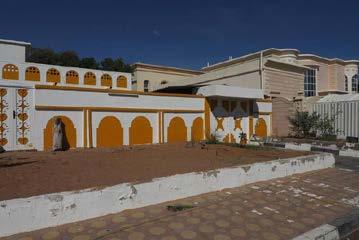
3 minute read
4.3 Contemporary Emirati Villas – Looking at the Sha’abi housing Typology with Nostalgia

The Emirati Sha’abi house program was at the time seen as a radical instrument ushering in modernity, yet also acting as a catalyst for the loss of cultural practices of local people. However, with the progression of time, Sha’abi houses started to be seen in a nostalgic manner by local people looking back at ‘old times’, where the houses are seen as not only places of memory, but as visual descriptions of transformation (Goodfriend, 2016), hence, enforcing their heritage value. This opposes the complicated relationship with the notion of heritage exhibited in Gulf countries, where the regional definition of heritage tends to embrace what could be showcased as more authentic, or, in other words, perceived as local, traditional, Khaleeji, Islamic, and most commonly – non-western derivative (Al-Qassimi & Fabbri, 2022).
Advertisement
The urban fabric produced in the Gulf during the modernization era lost its original meaning but acquired today the potential to narrate the social changes, economic growth, East–West dynamics typical of the region, and citizens’ memories of a recent past (Al-Qassimi & Fabbri, 2022). This newfound meaning of the once much contested Sha’abiya housing program is reinforced by the exponential growth of the city and its people, where local society has progressed to accept bourgeois consumerism, yet remaining socio-politically traditional, leaning on older values, as a defense mechanism against global forces that threaten national identity. ‘Identity’ is rarely defined and often invoked when the pace of change is perceived as a threat to prevailing norms (Al-Qassimi & Fabbri, 2022). In present times, Emiratis are tempted by more modern and larger villas with a large front garden (Fox, Sabah, & Al Mutawa, 2006) a suitable stage for the nouveaux rich to flout their prosperity. The contemporary Emirati villa is characterized by its huge, glazing, perimeter garden, sealed atrium, road facing orientation, and high energy consumption (Rashid,
Ara, & Abdalla, 2022). Due to the introduction of widespread air conditioning; accompanying increased prosperity; hermitically sealed spaces have eroded traditional transitional spaces, such as the courtyard.
Contemporary forms of dwelling are increasingly adapting Western principles, and thus an outward orientation, where in the West this compliments a vernacularly progressive, sociable, community-based neighborhood, in the UAE this leads to possible further disparity in community interaction. Western principles on community living cannot be transcribed into an Emirati context due to different cultural norms. The outward orientation of contemporary housing architecturally externalizes the culture of hospitality, a norm for which Arab’s are famous, this sentiment contradicts the important notion of privacy in Gulf culture. The notion of privacy in the Arab-Islamic paradigm is largely related to the requirement of modest self-preservation for Muslims in public, especially women (Sobh & Belk, 2011).
In the previous chapter on Sha’abi housing, high perimeter walls are criticized as they cause a gap between lived domestic space, and the intermediatory space found beyond the walls of the houses. Yet, common Emirati contemporary housing typologies, and their perceived outwardness further accentuate the boundaries between the ‘pure’ private sphere and the ‘contaminated’ public sphere (Sobh & Belk, 2011). Where the public sphere is perceived as ‘contaminated’ due to different social, public activity practiced by foreigners. The outward façade is rather symbolic of the contradiction found in the Emirati approach to ‘openness’. This clash of values further leads public opinion to look back at the superiorly culturally sensitive Sha’abi housing, now anchored within the Emirati heritage.
4.4 Conclusions
However, and despite its having often resulting in an incomplete vision, modernist architecture was the language – for better or for worse – of Gulf cities’ global aspirations in the twentieth century (Al-Qassimi & Fabbri, 2022). The contemporary architectural language, although contested in its form, if more structuralized could also construct the language with which to narrate social changes, economic growth, and East-West dynamics typical of the region. Thus, although not documented largely within current research, the contemporary UAE, and the architectural output in the form on housing can come to represent the current social climate. Which people in the coming years may look to for memories of the recent past. A past that is being constantly reconstructed, a past of a country which is re-finding its identity, a vital step of which is fluctuations in the social construct which is desired by the people and their government. The UAE must mature further for the repercussions of architecture on the social sphere to be adequately realized, this will still take time, and comes at the toll of derogatory consequences.


